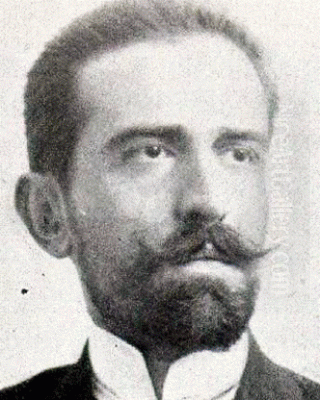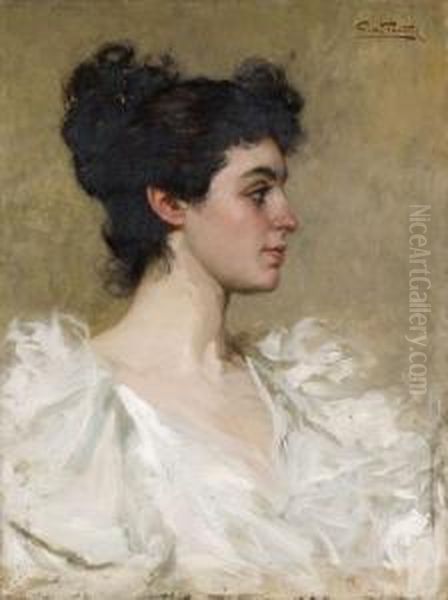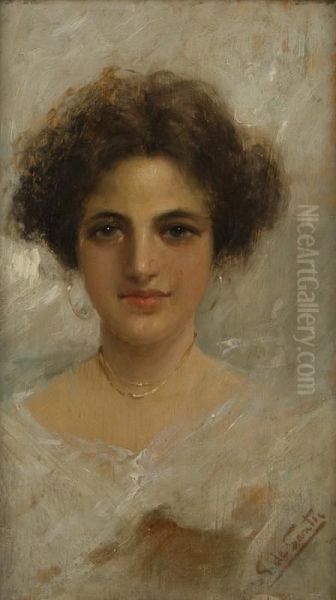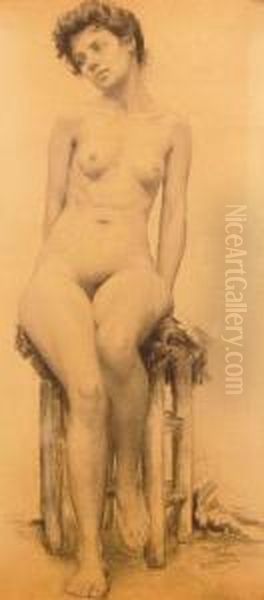
Giuseppe De Sanctis, born in Naples on June 21, 1858, and passing away in the same vibrant city on February 18, 1924, stands as a significant figure in the landscape of late 19th and early 20th-century Italian art. A prominent exponent of the Neapolitan school of painting, De Sanctis carved a niche for himself through his adept handling of historical subjects, evocative Orientalist scenes, and sensitive portraiture, particularly of women. His work reflects the rich artistic currents of his time, blending academic precision with a burgeoning realism and a romantic fascination with the exotic.
Early Life and Artistic Formation in Naples
The Naples into which Giuseppe De Sanctis was born was a city teeming with artistic energy and a long, distinguished cultural heritage. His decision to pursue an artistic career was reportedly encouraged by his family, providing a supportive environment for his burgeoning talent. The cornerstone of his formal artistic education was the prestigious Accademia di Belle Arti di Napoli (Naples Academy of Fine Arts). This institution was a crucible for many of Italy's finest artists, and it was here that De Sanctis honed his technical skills and absorbed the prevailing artistic philosophies.
During his formative years at the Accademia, De Sanctis came under the direct tutelage of Domenico Morelli (1826-1901). Morelli was a towering figure in Neapolitan art, a leading proponent of Realism with a Romantic sensibility, and a highly influential teacher. He encouraged his students to move beyond staid academic conventions, to embrace historical and literary themes with emotional depth, and to pay close attention to the effects of light and color. Morelli's impact on De Sanctis was profound, shaping his approach to composition, his thematic choices, and his painterly technique.
The Influence of Mariano Fortuny

Beyond the immediate influence of Morelli, another artist whose work cast a long shadow over De Sanctis, particularly in his earlier career, was the Spanish painter Mariano Fortuny y Marsal (1838-1874). Though Fortuny died relatively young, his dazzling technique, vibrant palette, and captivating Orientalist and Rococo-revival genre scenes had an electrifying effect on artists across Europe. Fortuny's meticulous detail, brilliant light, and almost jewel-like surfaces were widely admired and emulated. De Sanctis was clearly captivated by this "Fortunismo," and elements of its brilliance and exoticism can be discerned in his own explorations of similar themes.
The allure of Fortuny's style, characterized by its virtuosity and often sun-drenched depictions of historical or Eastern subjects, provided a compelling alternative or complement to the more somber or overtly nationalistic themes explored by some of his Italian contemporaries. For De Sanctis, Fortuny's influence likely encouraged a refinement of detail and an embrace of subjects that allowed for rich textural play and chromatic vibrancy.
Artistic Style: Realism, History, and the Exotic
Giuseppe De Sanctis's artistic output is characterized by a versatile command of different genres, though a few key stylistic threads run through his oeuvre. His foundation was in the academic realism championed by figures like Morelli, emphasizing accurate drawing, careful modeling of form, and believable representation of figures and environments. He possessed an excellent technical ability, evident in the confident brushwork and solid construction of his compositions.
A significant portion of his work delved into historical subjects, a popular genre in the 19th century that allowed artists to explore grand narratives, dramatic moments, and elaborate period costumes. These paintings often showcased his skill in staging complex multi-figure compositions and conveying a sense of historical authenticity. Alongside these, De Sanctis developed a strong penchant for Orientalist themes. Like many European artists of his era, he was drawn to the perceived exoticism, vibrant colors, and different cultural milieus of North Africa and the Middle East. These works often featured bustling marketplaces, serene interiors, and figures in traditional attire, rendered with an eye for detail and atmosphere.
Portraiture, especially of elegant women, was another forte. His portraits often combined a realistic likeness with an air of sophistication and psychological insight. He also painted genre scenes depicting everyday life, sometimes with a focus on Neapolitan urban settings, capturing the character and spirit of his native city. While rooted in realism, his works often carried a subtle romantic or poetic sensibility.
Key Works and Thematic Concerns

Several paintings stand out as representative of Giuseppe De Sanctis's artistic concerns and stylistic achievements. Among his notable works is La predica di Maometto (The Sermon of Mohammed), also known as Sermone di Maometto. This painting exemplifies his engagement with Orientalist themes and his ability to handle large-scale, narrative compositions. Such works allowed him to explore dramatic historical or religious moments set in richly detailed, exotic locales, appealing to the 19th-century European fascination with the East.
His skill in portraiture and genre scenes featuring female figures is evident in works like Donna e Vittoria (Woman and Victory), which likely combined allegorical elements with his refined depiction of the female form. Other titles attributed to him, such as Giovane Donna (Young Woman), L'Amante (The Mistress, 1898, reportedly housed in the Manolo Proietti Museum in Brazil), Ritratto di Fanciulla (Portrait of a Girl), and Nudo di Donna (Nude Woman), underscore his focus on the female subject, rendered with sensitivity and technical prowess. Figura Orientale (Oriental Figure) further highlights his dedication to Orientalist subjects, likely a smaller, more focused character study.
A work titled L'assassino parigino (The Parisian Assassin) suggests an engagement with contemporary urban drama or perhaps a historical scene set in Paris, indicating a breadth of thematic interest beyond purely Neapolitan or Orientalist subjects. These works, varying in scale and subject, collectively demonstrate his versatility and his consistent commitment to a high level of craftsmanship.
Travels and Broader European Influences
While Naples remained his primary base, De Sanctis, like many ambitious artists of his time, sought exposure to broader artistic currents. He is known to have spent time in Paris and London, then the epicenters of the European art world. In Paris, he would have encountered a dazzling array of artistic movements and influential figures. It is documented that he came into contact with prominent French academic painters such as Jean-Léon Gérôme (1824-1904) and Pascal Dagnan-Bouveret (1852-1929).
Gérôme was a master of academic classicism and a leading figure in the Orientalist genre, known for his meticulously detailed and often dramatic historical and Eastern scenes. His influence would have reinforced De Sanctis's own inclinations towards these subjects. Dagnan-Bouveret, a pupil of Gérôme, was celebrated for his naturalist paintings, often depicting peasant life with photographic precision and emotional depth. Exposure to such artists, and the vibrant Parisian art market, notably through figures like the art dealer Adolphe Goupil (1806-1893), who played a crucial role in popularizing artists like Gérôme and Fortuny, would have undoubtedly enriched De Sanctis's artistic perspective and connected him to international trends.
The Neapolitan Art Scene and Contemporaries

Back in Naples, De Sanctis was an active participant in the local art scene. He exhibited his works regularly, including at the Naples Salons of 1890 and 1899. He was also associated with the Circolo Artistico Politecnico, an artistic and cultural association founded in 1888 (some sources say 1890, promoted by the Academy of Fine Arts), which served as a meeting point for artists, intellectuals, and patrons, fostering a lively exchange of ideas.
Within this Neapolitan milieu, De Sanctis interacted with a host of talented contemporaries. The Neapolitan school of the late 19th century was rich and diverse, building on the legacy of figures like Giacinto Gigante (1806-1876) of the School of Posillipo, and the powerful realism of Domenico Morelli and Filippo Palizzi (1818-1899). Palizzi, like Morelli, was a key figure in moving Neapolitan art towards a more direct observation of nature and everyday life, often focusing on animal paintings and rural scenes.
Other notable painters active in Naples during De Sanctis's career included Gioacchino Toma (1836-1891), known for his poignant and often melancholic depictions of domestic life and social issues, and Francesco Paolo Michetti (1851-1929), who, though from Abruzzo, was deeply influenced by Morelli and Fortuny, and became renowned for his vibrant, large-scale depictions of regional life and customs. Antonio Mancini (1852-1930), another brilliant Neapolitan talent, developed a highly individualistic, impasto-laden style.
De Sanctis is also recorded as having collaborated with or been closely associated with artists such as Vincenzo Caprile (1856-1936), known for his lively genre scenes and views of Naples, and Vincenzo Migliaro (1858-1938), another painter celebrated for his depictions of Neapolitan life and landscapes. Other names linked with his circle include Paolo Vetri (1855-1937), a pupil of Morelli known for historical paintings and portraits, and Salvatore Postiglione (1861-1906), who also tackled historical and genre subjects. These interactions and shared artistic environment fostered a climate of mutual influence and creative development.
Later Career and Legacy
Giuseppe De Sanctis continued to paint and exhibit throughout his career, maintaining a reputation for his skillful and appealing works. His art, while perhaps not radically innovative in the context of the modernist upheavals that began to emerge in the early 20th century, represented a consistent and high-quality engagement with the established genres of his time. He successfully navigated the tastes of patrons who appreciated well-executed historical paintings, charming Orientalist scenes, and elegant portraits.
His dedication to his craft also extended to teaching, influencing a younger generation of artists. Among his students were Italo De Sanctis (likely a relative, though details are scarce) and Giacomo D'Albenzio, who would have carried forward aspects of his artistic approach.
The art of Giuseppe De Sanctis is often considered part of the broader artistic flourishing that occurred in Italy following its unification (the Risorgimento). While the main political events of the Risorgimento had concluded by the time De Sanctis began his career, the cultural project of forging a national identity and celebrating Italian history and regional diversity continued to inform the arts. His historical paintings can be seen in this light, contributing to a visual narrative of the past, while his genre scenes and Neapolitan subjects celebrated local character.
Conclusion: An Enduring Neapolitan Voice
Giuseppe De Sanctis remains a respected, if sometimes overlooked, figure within the rich tapestry of 19th-century Italian art. His work embodies the confluence of academic training, the realist impulse championed by Domenico Morelli, the dazzling technical influence of Mariano Fortuny, and the widespread European fascination with Orientalism. He was a versatile artist, adept at capturing the drama of history, the allure of distant lands, and the intimate charm of a portrait or a local scene.
His paintings, found in various public and private collections, continue to be appreciated for their technical accomplishment, their narrative interest, and their evocative power. As a product of the vibrant Neapolitan artistic environment, and a participant in the broader European art world through his travels and influences, Giuseppe De Sanctis contributed a distinctive voice to the art of his era. His legacy lies in his beautifully crafted canvases that offer a window into the artistic tastes and cultural preoccupations of late 19th and early 20th-century Italy, particularly through the skilled hands of a dedicated Neapolitan master. His connection to influential figures like Morelli, Gérôme, and Fortuny, and his place among a generation of talented Neapolitan painters such as Caprile, Migliaro, and Postiglione, solidify his importance in the history of Italian art.